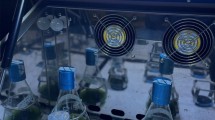Abstract
Production of biomass and phycocyanin (PC) were investigated in highly pigmented variants of the unicellular rhodophyte Galdieria sulphuraria, which maintained high specific pigment concentrations when grown heterotrophically in darkness. The parental culture, G. sulphuraria 074G was grown on solidified growth media, and intensely coloured colonies were isolated and grown in high-cell-density fed-batch and continuous-flow cultures. These cultures contained 80–110 g L−1 biomass and 1.4–2.9 g L−1 PC. The volumetric PC production rates were 0.5–0.9 g L−1 day−1. The PC production rates were 11–21 times higher than previously reported for heterotrophic G. sulphuraria 074G grown on glucose and 20–287 times higher than found in phototrophic cultures of Spirulina platensis, the organism presently used for commercial production of PC.




Similar content being viewed by others
References
Albertano P, Civilian C, Pinto G, Polio A (2000) The taxonomic position of Cyanidium, Cyanidioschyzon and Galdieria: an update. Hydrobiologia 433:137–143
Chen F (1996) High cell density culture of microalgae in heterotrophic growth. Trends Biotechnol 14:421–426
Chen F, Zhang Y (1997) High cell density mixotrophic culture of Spirulina platensis on glucose for phycocyanin production using a fed-batch system. Enzyme Microb Technol 20:221–224
Gross W (2000) Ecophysiology of algae living in highly acidic environments. Hydrobiologia 433:31–37
Gross W, Schnarrenberger C (1995) Heterotrophic growth of two strains of the acido-thermophilic red alga Galdieria sulphuraria. Plant Cell Physiol 36:633–638
Gross W, Küver J, Tischendorf G, Bouchaala N, Büsch W (1998) Cryptoendolithic growth of the red alga Galdieria sulphuraria in volcanic areas. Eur J Phycol 33:25–31
Houghton JD, Turner L, Brown SB (1988) The effect of gabaculine on tetrapyrrole biosynthesis and heterotrophic growth of Cyanidium caldarium. Biochem J 254:907–910
Jiménez C, Cossío BR, Labella D, Niell FX (2003) The Feasibility of industrial production of Spirulina (Arthrospira) in Southern Spain. Aquaculture 217:179–190
Kursar TA, Alberte RS (1983) Photosynthetic unit organisation in a red alga. Relationships between light-harvesting pigments and reaction centres. Plant Physiol 72:409–414
Moreno J, Vargas MA, Rodríguez H, Rivas J, Guerrero MG (2003) Outdoor cultivation of a nitrogen-fixing marine cyanobacterium, Anabaena sp. ATCC 33047. Biomol Eng 20:191–197
Pushparaj B, Pelosi E, Tredici MR, Pinzani E, Materassi R (1997) An integrated culture system for outdoor production of microalgae and cyanobacteria. J Appl Phycol 9:113–119
Rhie G, Beale SI (1994) Regulation of heme oxygenase activity in Cyanidium caldarium by light, glucose, and phycobilin precursors. J Biol Chem 269:9620–9626
Searle PL (1984) The Berthelot or indophenol reaction and its use in the analytical chemistry of nitrogen. A review. Analyst 109:549–568
Schmidt RA, Wiebe MG, Eriksen NT (2005) Heterotrophic high cell-density fed-batch cultures of the phycocyanin producing red alga Galdieria sulphuraria. Biotechnol Bioeng 90:77–84
Sloth JK, Wiebe MG, Eriksen NT (2006) Accumulation of phycocyanin in heterotrophic and mixotrophic cultures of the acidophilic red alga Galdieria sulphuraria. Enzyme Microb Technol 38:168–175
Stadnichuk IN, Rakhimberdieva MG, Bolychevtseva YV, Yurina NP, Karapetyan NV, Selyakh IO (1998) Inhibition by glucose of chlorophyll a and phycocyanobilin biosynthesis in the unicellular red alga Galdieria partita at the stage of coproporphyrinogen III formation. Plant Sci 136:11–23
Stadnichuk IN, Rakhimberdieva MG, Boichenko VA, Karapetyan NV, Selyakh IO, Bolychevtseva YV (2000) Glucose-induced inhibition of the photosynthetic pigment apparatus in heterotrophically-grown Galdieria partita. Russ J Plant Physiol 47:585–592
Troxler RF, Bogorad L (1966) Studies on the formation of phycocyanin, porphyrins, and a blue phycobilin by wild-type and mutant strains of Cyanidium caldarium. Plant Physiol 41:491–499
Acknowledgements
We thank Dr. Marilyn G. Wiebe for critically reading the manuscript.
Author information
Authors and Affiliations
Corresponding author
Rights and permissions
About this article
Cite this article
Graverholt, O.S., Eriksen, N.T. Heterotrophic high-cell-density fed-batch and continuous-flow cultures of Galdieria sulphuraria and production of phycocyanin. Appl Microbiol Biotechnol 77, 69–75 (2007). https://doi.org/10.1007/s00253-007-1150-2
Received:
Revised:
Accepted:
Published:
Issue Date:
DOI: https://doi.org/10.1007/s00253-007-1150-2




